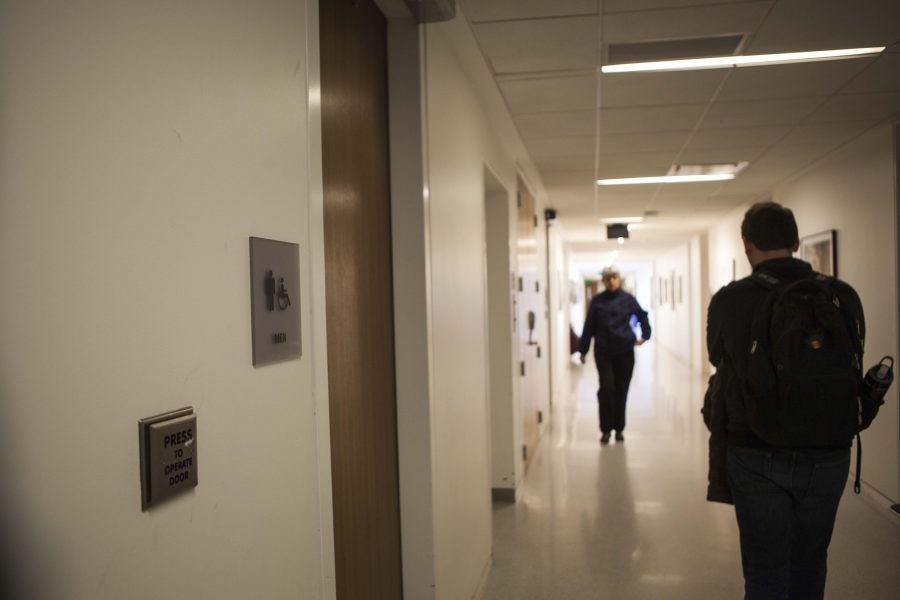Bibbins Renovations Add Gender-Neutral Restrooms
Gone TIMAROW Longtime TIMARA engineer celebrates nal semester. See page 10 Photo by Bryan Rubin, Photo editor
Students pass a men’s restroom in Bibbins Hall, a Conservatory building that has no gender-neutral bathrooms. Renovations this summer will address this issue as gender-neutral bathrooms will be included on the first- and third-floors of the building.
March 3, 2017
Though all of Oberlin’s dormitories contain gender-neutral bathroom facilities, many academic buildings have lagged in adding such spaces. is summer, renovations to Bibbins Hall, the Conservatory’s primary building, will address students’ concerns with the installation of gender-neutral bathrooms.
Conservatory students, namely junior Zoe Cutler and sophomore William Adams, consulted Title IX coordinators in fall 2015 about the absence of neutral facilities in Bibbins. Renovations that took place last summer, however, excluded the facility renovations many hoped to return to this academic year. The Conservatory currently has two gender-neutral bathrooms, one in Robertson Hall and one in the Kohl Jazz Studies Building’s third floor. In an email to Conservatory students Tuesday, Dean of the Conservatory Andrea Kalyn introduced the renovation plans.
“It is Oberlin College and Conservatory’s policy that all persons are at liberty to use bathrooms consistent with their gender identity; this policy of inclusion remains intact, despite recent federal directives,” Kalyn wrote, referencing President Donald Trump’s recent rescindment of protections for trans students in public schools. “It must also be acknowledged that our aging facilities [do] not promote this policy as well as we would prefer, and certainly we are working to rectify this in the course of our ongoing renovation projects.”
According to the Conservatory’s Associate Dean of Facilities and Technology Michael Straus, the first floor of Bibbins will be renovated to include one women’s bathroom and one all-gender bathroom, and the third floor will include one men’s bathroom and one all-gender bathroom. Straus added that all three of Kohl’s single-use bathrooms will become gender-neutral.
“Since 2012, we’ve been slowly renovating bits and pieces of Bibbins,” Straus said, explaining that the renovations have included plans for these facilities for a while but the process occurs in stages. “This coming summer, we’ll be renovating the basement and hitting all the miscellaneous stuff we haven’t been able to get to the past few years.”
In addition to changes in the Conservatory, Title IX Coordinator Rebecca Mosley said that StudiOC, an extension of the Peter B. Lewis Gateway Center, and the Cox Administration Building, which will also undergo renovations this summer, will include gender-neutral bathrooms. These additions are reflective of ongoing efforts to add more neutral facilities, as seen in Wilder Hall’s basement and in the Birenbaum at the Hotel at Oberlin. Next, some students hope that gender-neutral facilities are in the works for other academic buildings like King Building and Peters Hall.
“It needs to happen on other buildings on campus, because while it’s great that it’s happening in the Con, statistically in terms of numbers of students in the school, it’s not even half of the students that it’s benefiting,” Adams said. “King and Peters need these changes made, and students are used to using gender-neutral bathrooms in their dorms and such anyways. We’re not saying to make them all gender-neutral. I understand that there still needs to be gendered bathrooms, but it just benefits people in so many ways.”
Mosley said that she and others in the Office of Equity, Diversity and Inclusion are addressing these changes in the face of budgetary and temporal factors that have placed barriers toward completing more projects of a similar nature. Last fall, Mosley held meetings with faculty as part of a study about single-use or gender-neutral bathrooms that already exist. After locating where gender-neutral bathrooms are absent, Mosley mulled the option of designing a system that let people know where the closest gender-neutral bathroom was.
“One of the things that we’re working on in the short-term is to be able to do some signage around all of the restrooms on campus that are not all-gender right now and be able to tell someone who wanted to use an all-gender restroom where the nearest one is,” Mosley said, adding that more gender-neutral facilities will come into conversation when buildings like King and Peters are scheduled for renovations.
Although students like Cutler and Adams have long advocated for the establishment of more gender-inclusive facilities on campus, Cutler acknowledged that relative to other schools and parts of the country, Oberlin is still progressive in making these changes.
“Oberlin students often expect institutional change to happen quite fast, and it often doesn’t meet our expectations,” Cutler said. “While I wish the Conservatory had completed these renovations last summer, I recognize that converting the bathrooms is happening faster than many institutional changes.”
While Adams said he was optimistic about the incoming changes, he also said he was frustrated with the larger national movement that the Trump administration has perpetuated in rescinding trans rights.
“What the Trump administration has been doing makes me mad because it targets some of the most vulnerable students in areas where they’re just trying to be themselves, and there aren’t laws to protect them boards and there aren’t sympathetic school districts and boards,” Adams said. “It’s ridiculous.”
























